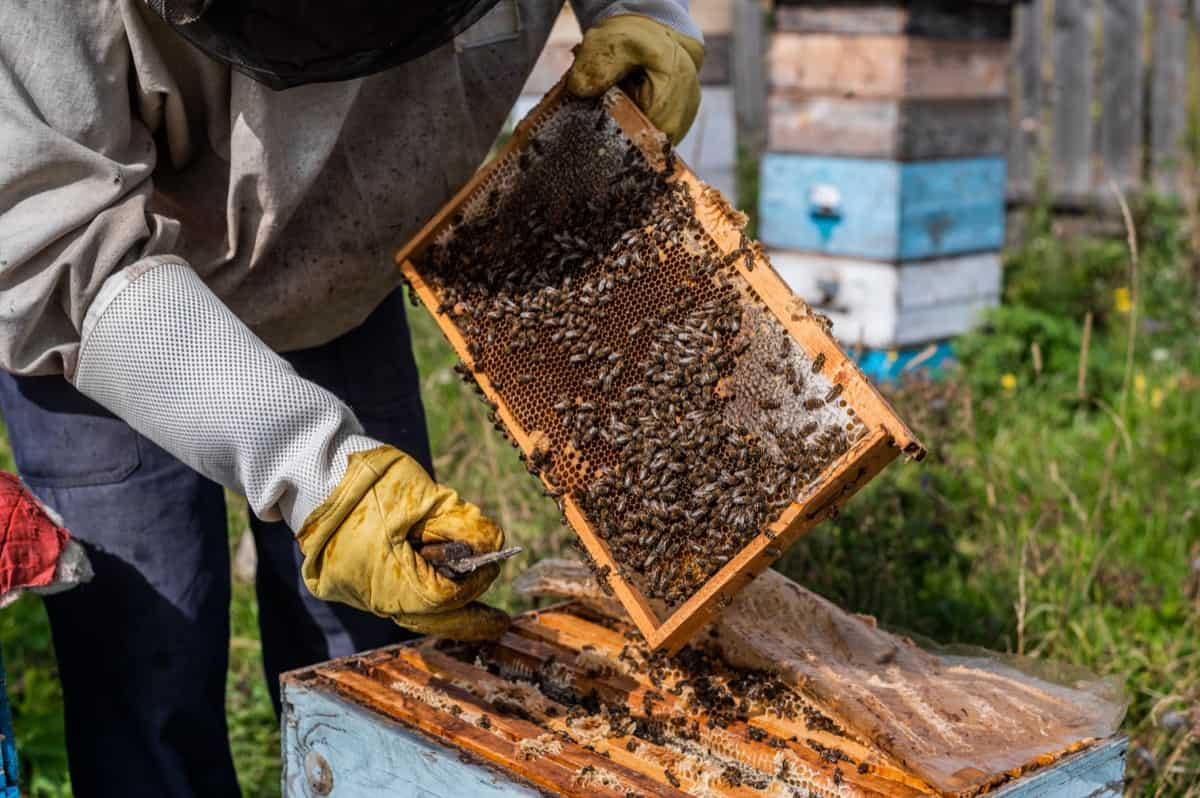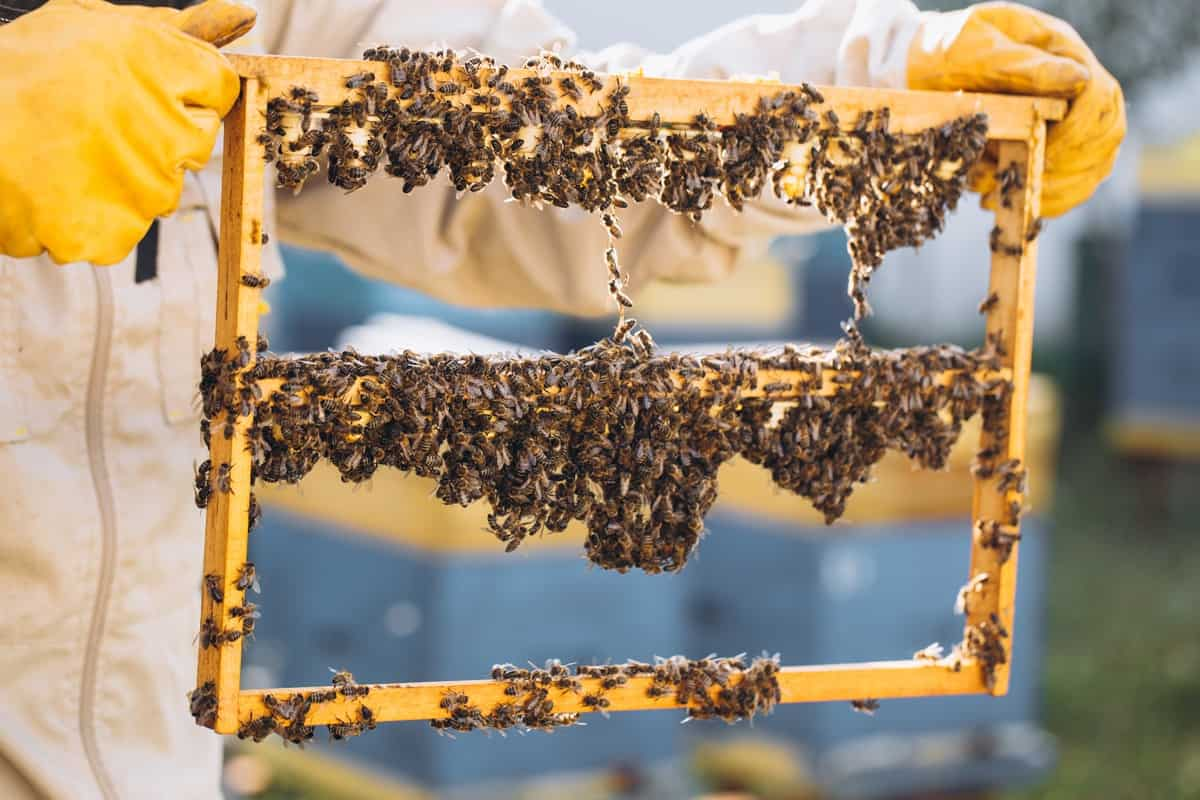Bee Breeding and Genetics are crucial for optimal performance in advancing honey bee stock. This guide delves into the fundamentals of honey bee stock improvement. It emphasizes the significance of selective breeding in honing desirable traits, highlighting genetic diversity’s advantages and challenges.

Disease resistance strategies are examined, addressing the pressing issue of hive health. The pursuit of higher honey yields through improved stock and efforts to enhance pollination efficiency are explored. The guide also underscores the importance of temperament and Varroa mite resistance. Additionally, modern genetic markers and techniques revolutionize bee breeding. Finally, we glimpse into the future of this vital field.
The Importance of Selective Breeding in Enhancing Honey Bee Traits
Selective breeding is a cornerstone in the quest to enhance honey bee traits. This method allows beekeepers to intentionally propagate desirable characteristics, such as honey production, temperament, and disease resistance. By identifying and pairing colonies with exceptional traits, successive generations can exhibit marked improvements. For instance, selecting for honey production can lead to higher yields, benefiting both beekeepers and agriculture. Likewise, choosing calm and docile bees enhances colony management safety.
However, selective breeding demands patience and meticulous record-keeping. Genetic diversity within bee populations must be maintained to prevent unintended consequences, such as reduced adaptability. It’s essential to strike a balance between selection and genetic variability. Harnessing the power of selective breeding empowers beekeepers to sculpt bee populations that are more productive and better adapted to environmental challenges, ensuring the sustainability of these vital pollinators.
Genetic Diversity in Honey Bees: Exploring the Benefits and Challenges
Genetic diversity in honey bee populations is a double-edged sword, offering both benefits and challenges. A diverse gene pool contributes to adaptability, helping colonies cope with changing environments and threats. It bolsters resilience against diseases, parasites, and environmental stressors. Different genetic traits provide a variety of responses, increasing the odds of survival.
However, maintaining genetic diversity presents challenges. The intensification of beekeeping practices can inadvertently reduce diversity by favoring certain traits and restricting breeding options. This makes populations vulnerable to novel pathogens or environmental shifts. Beekeepers must carefully manage selection to balance desired traits with genetic variability.
Breeding Strategies for Disease Resistance in Honey Bee Populations
Disease resistance is a paramount concern in honey bee populations. Breeding strategies aim to develop bees with natural resistance to common threats like Varroa mites and Nosema. One approach is selectively propagating colonies demonstrating resistance traits, such as grooming behavior against mites. Another involves incorporating hygienic behavior genes, enabling bees to detect and remove infected larvae.
In case you missed it: Beekeeping Suits and Protective Gear: Choosing the Right Fit

These strategies, however, require careful monitoring and evaluation. Constant surveillance of disease prevalence and genetic traits is essential to identify and propagate resistant colonies effectively. Additionally, beekeepers must remain vigilant to prevent resistance-breaking strains of pathogens from emerging. By employing a combination of selective breeding and advanced molecular techniques, we can mitigate the devastating impact of diseases on honey bee populations, promoting their long-term health and vitality.
Improving Honey Bee Stock for Increased Honey Production
Enhancing honey bee stock is essential for boosting honey production. Bee breeding and genetics play a pivotal role in achieving this goal. Selective breeding aims to propagate traits that favor higher honey production. By carefully selecting queen bees with desirable characteristics, such as prolific egg-laying and efficient foraging, beekeepers can enhance the overall productivity of their colonies.
Genetic diversity is also crucial to maintaining robust bee populations. Inbreeding can lead to weakened colonies with lower honey yields. Beekeepers must introduce genetic diversity by regularly importing new queens or genetic material from different regions or bee populations to counter this.
Additionally, genetics can be used to identify and breed bees that are more resistant to diseases and pests, reducing colony losses and ensuring consistent honey production. Scientists can identify specific genes associated with desirable traits through molecular techniques and accelerate breeding.
Enhancing Pollination Efficiency Through Bee Breeding and Genetics
Bee breeding and genetics are crucial in improving honey bee stock for enhanced pollination efficiency. By selecting traits such as increased foraging behavior, disease resistance, and reproductive capacity, beekeepers can cultivate bee colonies that are more productive and better suited for crop pollination. Breeding programs aim to produce bees with improved flight endurance, allowing them to cover larger foraging areas and greater attraction to flowering plants.
Additionally, genetics can be leveraged to reduce undesirable traits, such as aggressiveness and swarming tendencies, which can disrupt bee colonies. Overall, strategic bee breeding and genetics programs enable the development of honey bee populations that contribute significantly to the agricultural industry by optimizing pollination, ultimately increasing crop yields and food production while ensuring the health and vitality of bee colonies.
Selecting for Temperament: Creating Calm and Docile Honey Bee Colonies
Selecting for temperament in honey bee colonies is essential for fostering calm and docile behavior, which benefits both beekeepers and bees. Breeding programs emphasizing gentle temperament traits can significantly reduce the risk of bee stings and make hive management more manageable. Docile honey bee colonies are less likely to become agitated during inspections, making it easier for beekeepers to tend to their hives and monitor bee health.
In case you missed it: Beekeeping: Understanding the Basics of Apiculture

Calmer bees are also less prone to absconding or swarming, which helps maintain stable and productive colonies. Genetic selection for peaceful behavior involves choosing queen bees with milder dispositions and integrating these genetics into the overall bee population. By prioritizing temperament traits through bee breeding and genetics, beekeepers can create more pleasant colonies to work with and reduce stress for the bees and their caretakers.
Breeding for Varroa Mite Resistance: Combating a Major Threat to Honey Bees
Varroa mites pose a severe threat to honey bee populations worldwide. To combat this menace, beekeepers increasingly focus on breeding programs to enhance Varroa resistance in honey bee stocks. Selective breeding for traits like grooming and hygienic behavior, which help bees remove mites from their colonies, is essential.
Genetic markers and quantitative trait loci (QTL) analysis can identify genes associated with mite resistance. Breeding programs should prioritize queen bees with these genes to propagate resistant colonies. Moreover, controlled mating with drones from Varroa-resistant colonies can accelerate resistance spread. By applying these strategies, beekeepers can develop honey bee stocks better equipped to withstand Varroa mite infestations, safeguarding honey bee populations and pollination services.
Genetic Markers and Molecular Techniques in Bee Breeding
Genetic markers and molecular techniques are crucial in modern bee breeding programs. They enable beekeepers to select and propagate desirable traits efficiently. DNA markers and QTL analysis allow for identifying genes associated with traits like honey production, disease resistance, and Varroa mite resistance.
These tools help beekeepers make informed breeding decisions, leading to improved honey bee stock. Molecular techniques also aid in parentage verification and tracking genetic diversity within colonies. By integrating genomics and selective breeding, beekeepers can accelerate the development of honey bee populations with superior characteristics, ensuring their health and productivity.
Future Directions in Bee Breeding and Genetics
The future of bee breeding and genetics holds promise for honey bee sustainability. Advanced genomic techniques will enable precise trait selection, enhancing resistance to threats like Varroa mites and diseases. Moreover, gene editing technologies may allow for the direct modification of bee genes, opening possibilities for targeted trait improvements. Sustainable breeding practices will prioritize maintaining genetic diversity to prevent inbreeding depression.
Beekeepers will collaborate globally to share genetic resources and knowledge, fostering resilience in honey bee populations. Future directions in bee breeding and genetics aim to develop robust and adaptable honey bee stocks, ensuring their crucial role in pollination and ecosystem health.
In case you missed it: Honey Bee Management for Maximum Honey Production

Conclusion
In the ever-evolving landscape of bee breeding and genetics, innovation promises to revolutionize honey bee stock improvement further. With a focus on sustainability and resilience, ongoing research will pave the way for healthier, more productive colonies. As we unlock the potential within honey bee genomes, we forge a path towards a more secure future for these essential pollinators and the ecosystems they support.
- Feed Your Flock for Less: Top 10 Tips to Save on Chicken Feed
- Ultimate Guide to Ossabaw Island Hog: Breeding, Raising, Diet, and Care
- Hatching Answers: The Top 10 Reasons Your Chickens Aren’t Laying Eggs
- Eggs and Economics: Breaking Down the Cost of Raising Backyard Chickens
- Defend Your Greens: Proven Methods to Keep Iguanas Out of Your Garden
- Ultimate Guide to Cinnamon Queen Chicken: A Comprehensive Guide for Beginners
- Ultimate Guide to California Tan Chicken: Breeding, Raising, Diet, Egg-Production and Care
- Ultimate Guide to Marsh Daisy Chicken: Breeding, Raising, Diet, and Care
- 10 Types of Chicken Farming Businesses You Can Start for Profits